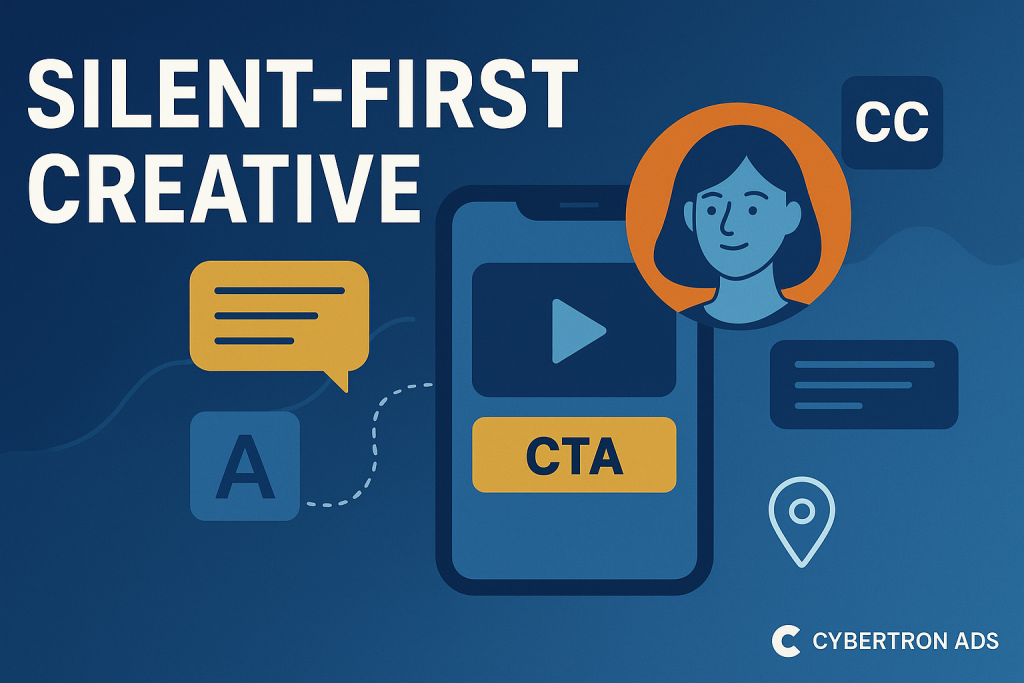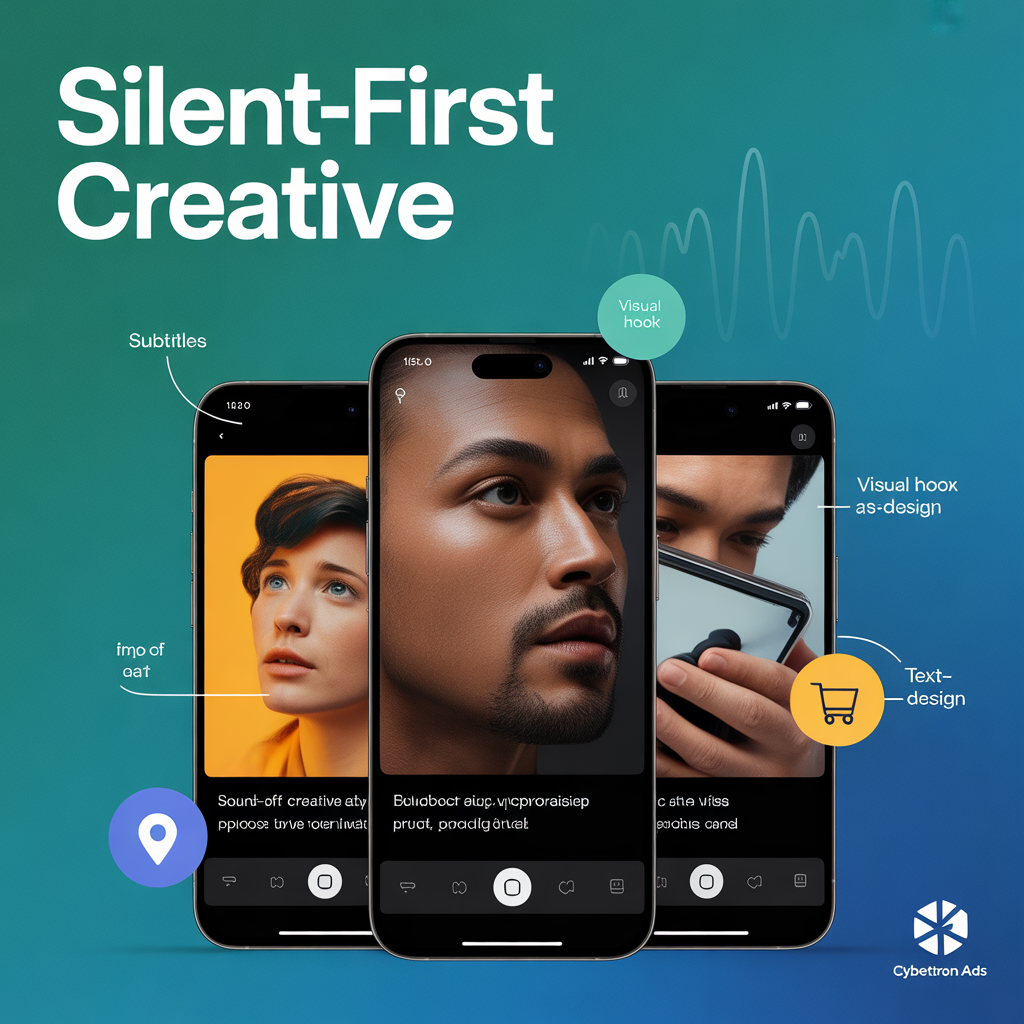Estimated read: 6–8 minutes • ~1,050 words
People scroll fast. Mobile feeds autoplay videos muted by default, public spaces are noisy, and attention is fragmented. If your creative relies on audio to make sense, most viewers will never hear the punchline.
Silent-first creative is a practical, revenue-driven approach: design assets that communicate the idea, value, and call-to-action even when sound is off. It’s not about banning audio — it’s about making visuals and typography the primary vehicle for meaning, then using sound as an enhancer for viewers who opt-in.
Below is an SEO-ready playbook that media teams, creative leads, and growth operators can use immediately.
Why silent-first creative matters now
- Default behavior: Social platforms and in-app environments commonly autoplay muted video. Users only enable sound if the creative compels them.
- Contextual reality: People watch in transit, at work, or in public — sound is often impractical.
- Performance upside: Creatives that read without audio tend to increase view-through rates, completion, and micro-conversions because they respect the viewer’s context.
- Accessibility: Subtitles and clear visuals broaden reach and demonstrate inclusive design.
In short: designing for sound-off is both a performance and a UX strategy.

Core design principles
Make the creative communicate instantly and unambiguously.
- One idea per frame. Each frame should convey a single message: benefit, moment, or instruction. Avoid visual clutter.
- Kinetic typography as voice. Animated text delivers your key line within the first 1–2 seconds — it becomes your “voice” when sound is off.
- Micro-story arc. Use a 3-panel structure: Problem → Moment → Action. It works for 6–10s video, carousels, and hero images.
- Product-in-context imagery. Show the product in real life to communicate value faster than specs.
- Visual CTA affordance. Use clear visual cues (map pin icon, large button, one-tap affordance) so action is obvious without audio.
- Captions as design elements. Treat captions like a core part of the creative, not an afterthought — big, legible, high-contrast.
- Early brand cue. Offer a subtle brand marker in the first second so viewers form an association quickly.
High-performing silent-first formats
- 6–10 second micro-video: Rapid problem → solution → CTA loop optimized for completion.
- 3-card micro-story carousel: Each card is a beat of the narrative; swipes equal engagement.
- Cinemagraphs or subtle motion: Motion draws eyes without requiring audio.
- Still hero with kinetic overlay: Strong image + bold typographic headline + visual CTA.
- Interactive units (polls, sliders): Invite touch and require no sound to understand.
Test design: validate before you scale
Run structured micro-tests with clear hypotheses and attention-first metrics.
Example test setup
- Hypothesis: A silent-first variant with kinetic text yields higher Engaged Seconds (ES) and micro-conversions than the original sound-dependent spot.
- Variants: A = original (sound-dependent); B = silent-first with kinetic text; C = B + burned-in captions.
- Primary KPIs (attention-first): Engaged Seconds → Completion Rate → Micro-conversions (map opens, CTA taps) → Conversion.
- Cadence: 7–14 days per test; use a holdout when possible for incremental measurement.
Analyze like this: review median and 75th-percentile ES, completion rates, and downstream micro-actions. If B outperforms A on attention and micro-actions, promote it into DCO and run a scale test.
Operational rules to scale silent-first creative
- Make captions mandatory. Require SRT files or burned-in subtitles with every video deliverable.
- One variable per test. Change a single major element so results are attributable.
- DCO templates built for silent-first. Create modular templates (hero, headline, CTA, badge) that swap assets without re-editing timing.
- Consistent naming & tagging. Use standardized asset tags (e.g., silent_v1_caption_on) so analytics tie creative to performance automatically.
- Creative archive & learnings. Store winners and context notes in a searchable library for future reuse.
Attention-first KPIs that matter
- Engaged Seconds (ES): primary short-term signal of attention.
- Viewability %: share of impressions meeting the viewability standard.
- Completion Rate (video): measures whether the micro-story landed.
- Micro-conversions: low-friction intent actions (map open, call tap, form start).
- Creative decay rate: tracks performance drop-off over time to schedule refreshes.
A winner should move both attention and micro-actions — not just one or the other.
Quick 30–60 day starter checklist
- Audit: pick three sound-dependent creatives.
- Convert: produce silent-first variants (kinetic text, captions, one-tap CTA).
- Test: run A/B micro-tests across in-feed mobile and programmatic placements (7–14 days).
- Measure: track ES, completion, and micro-actions; use holdouts where possible.
- Scale: promote winners into DCO templates and incrementally increase spend.
Mini-case (illustrative)
A food-delivery brand replaced a sound-reliant hero with a 6s silent-first spot: hungry user → bold kinetic text “Food in 20” → big “Order” CTA. In a 10-day micro-test the silent variant improved completion by 30% and one-tap orders by 18% (hypothetical example). The lesson: a clear idea executed fast beats cinematic complexity when attention is short.
Accessibility & brand impact
Silent-first creative is inclusive design — captions help people with hearing loss and those in public spaces. Brands that respect audience context build trust and increase reach. That’s both good UX and good business.
Final thought: sound is an enhancer, not a crutch
Sound can amplify emotion — but it should never be required to understand the message. Treat audio as an upgrade for those who choose it, and design the core experience to land visually. Do that, and your ads will win the scroll in the real contexts that matter.
Ready to make your creative work without sound? Cybertron Ads builds DCO templates, runs micro-tests, and measures attention-first KPIs so winning creative becomes repeatable.
👉 [Book a 15-minute strategy session with Cybertron Ads] (https://calendly.com/cybertronadvertising/meeting)
